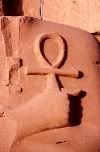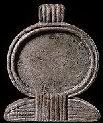

The Ankh is an Egyptian symbol of life carried by gods and royalty. It is shaped like a capital T with a loop at the top. When depicted in images of gods and pharaohs, it is usually carried by this loop. It is identified with the Greek Tau and the Christian crux ansata. Though it is a symbol of life everlasting, it has its humble beginnings as a stylized sandal strap. Really, what is more appropriate as a symbol of life than something associated with the feet, which carry us through it to the end? The Ankh is also said to represent a mirror, perhaps under the assumption that the mirror always reflected one's true face or soul.
Various theories has been offered to explain the Ankh's symbolism. It was known as the key of the Nile because it was said to represent the union of Isis and Osiris. Some nineteenth century scholars stated the ankh represented the male and female organs, while others stated the T stood for an altar with an egg or vase set upon it. Early Egyptian Christians adopted it as their sign.

The Ankh is similar to the Shen, a symbol of eternity carried in the annual feast of Osiris at the rising of the Nile. It is also laid at the feet of the dead. The Shen appears to be a circle or ring with a flat sidepiece. In addition to appearing in the company of Osiris, the Shen is also shown in the claws of vultures and hawks. Isis and Nephthys are shown kneeling and resting their hands on a Shen.